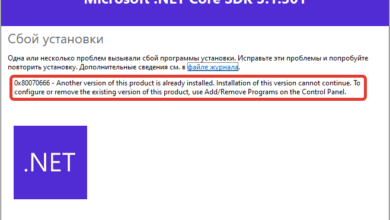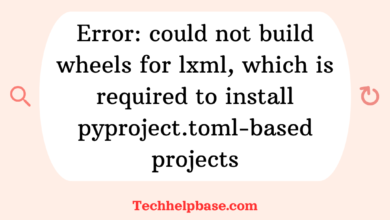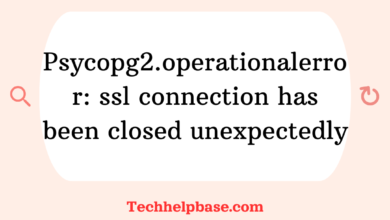Preparing metadata (setup.py) … error error: subprocess-exited-with-error

When working with Python packages, especially during installations or updates, you may encounter the error [preparing metadata (setup.py) ... error error: subprocess-exited-with-error]. This problem occurs frequently in package management, and it stems from an issue during the metadata preparation phase, which is typically handled by setup.py within a Python package.
What does it mean?
The error message indicates that something went wrong when Python tried to generate metadata for the package before installing it. The error suggests that the subprocess responsible for running this part of the installation terminated unexpectedly.
Common Causes
Several factors can trigger this issue, ranging from environment conflicts to outdated dependencies. Here are some of the main causes:
- Outdated Python or Pip Version
If your Python or Pip version is outdated, it may lack compatibility with newer package dependencies, causing thesubprocess-exited-with-errormessage during metadata preparation. This is particularly common when working with complex packages that depend on newer Python versions. - Missing Build Tools
Some packages require specific build tools likegcc(GNU Compiler Collection) orpython-dev(development headers) to compile correctly. If these are not installed, it can lead to this error, particularly on Linux or macOS systems. - Corrupted Virtual Environment
A corrupted or improperly configured virtual environment can cause metadata generation to fail, especially if the environment’s dependencies are out of sync with the global system. - Incompatible Dependencies
When multiple packages require different versions of the same library, Pip may struggle to resolve dependencies, leading to subprocess failures during metadata preparation. - Custom Setup Scripts
If the package uses a non-standard or complexsetup.pyscript, it could cause errors during execution. Some setup scripts run external processes that can fail or crash, leading to the[preparing metadata (setup.py) ... error error: subprocess-exited-with-error].
Real-World Examples
Users across Python forums and StackOverflow have reported various instances of this error. A common situation is when developers try to install or update libraries like cryptography, psycopg2, or other packages that involve compiled code. For example, one user on a forum shared how the error appeared when they attempted to install cryptography after upgrading their Python version. Another user reported the issue with psycopg2 due to missing PostgreSQL headers.
Troubleshooting the Error
Resolving the [preparing metadata (setup.py) ... error error: subprocess-exited-with-error] problem requires a step-by-step approach since the causes vary. Below are several troubleshooting methods:
1. Update Python and Pip
One of the first steps you should take is to ensure that both Python and Pip are up to date.
- Check Python Version
Run the command:python --versionIf you’re not using the latest version, consider upgrading. You can upgrade Python by downloading it from the official Python website or using a package manager. - Update Pip
Update Pip by running:pip install --upgrade pipThis command ensures you’re using the latest package installer, which might resolve compatibility issues during installation.
2. Install Required Build Tools
For packages that require compilation, such as cryptography or psycopg2, missing build tools can cause this error. Install the necessary tools based on your operating system:
- For Ubuntu/Linux:
sudo apt-get install build-essential python3-dev - For macOS: You may need to install Xcode command line tools:
xcode-select --install
3. Check Virtual Environment
If you’re using a virtual environment, ensure it’s properly configured. Sometimes, creating a new virtual environment can resolve the issue:
- Create a new environment:
python -m venv myenv source myenv/bin/activate - Install the required packages again:
pip install package-name
This resets the environment, removing any conflicts or issues with the global system.
4. Resolve Dependency Conflicts
If the problem arises from conflicting dependencies, you can use Pip’s --use-deprecated=legacy-resolver flag to bypass the dependency resolution system:
pip install package-name --use-deprecated=legacy-resolver
This forces Pip to use its older dependency resolver, which may be able to work around conflicts.
5. Manual Package Installation
In some cases, installing the package manually can resolve the issue. Download the package from PyPI and run the installation from the source:
pip download package-name
tar -xvf package-name.tar.gz
cd package-name
python setup.py install
This allows you to see more detailed error messages during the installation process and might help pinpoint the exact cause of the error.
6. Install Dependencies Separately
If the error persists, try installing dependencies one by one, which can isolate the issue. For example:
pip install dependency1
pip install dependency2
pip install main-package
This method often helps when one specific dependency causes the failure.
Preventing Future Issues
To prevent similar errors in the future, it’s essential to maintain a clean and organized development environment:
- Use Virtual Environments:
Always work within a virtual environment to isolate project dependencies. This minimizes conflicts between global and local package installations. - Keep Pip and Python Updated:
Regularly updating both Python and Pip ensures compatibility with newer packages and reduces the likelihood of encountering errors during installation. - Pin Dependencies in
requirements.txt:
Pinning your dependencies (specifying exact versions) in arequirements.txtfile helps ensure consistent package versions across different environments, reducing the chance of incompatibility issues.




